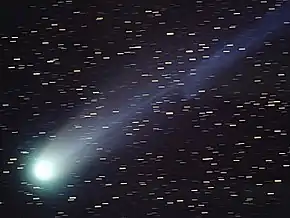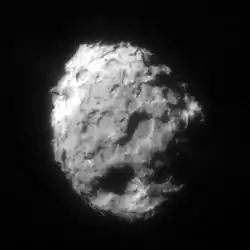C/1861 G1 (Thatcher)
Comet C/1861 G1 (Thatcher) is a long-period comet with roughly a 415-year orbit that is expected to return around 2283. It was discovered by A. E. Thatcher. It is responsible for the April Lyrid meteor shower.[3] Carl Wilhelm Baeker also independently found this comet. The comet passed about 0.335 AU (50.1 million km; 31.1 million mi) from the Earth on 1861-May-05 and last came to perihelion (closest approach to the Sun) on 1861-Jun-03.[1]
| Discovery | |
|---|---|
| Discovered by | A. E. Thatcher |
| Discovery date | April 5, 1861 |
| Alternative designations | 1861 I |
| Orbital characteristics A | |
| Epoch | JD 2400920.5 (May 25, 1861) |
| Orbit type | Long period comet |
| Aphelion | 110 AU (beyond Eris) |
| Perihelion | 0.9207 AU |
| Semi-major axis | 55.6 AU |
| Eccentricity | 0.983 |
| Orbital period | 415 a |
| Inclination | 79.77° |
| Last perihelion | 1861-Jun-03[1] |
| Next perihelion | 2283 ±5[2] |
C/1861 G1 is listed as a long-period "non-periodic comet" because it has not yet been observed at two perihelion passages. When it is seen to come back around 2283, it should receive the P/ designation.
The comet is the parent body of the April Lyrids meteor shower.
References
- "JPL Small-Body Database Browser: C/1861 G1 (Thatcher)". Jet Propulsion Laboratory. Retrieved 2012-04-21.
- Horizons output. "Observer Table for Comet C/1861 G1 (Thatcher)". Retrieved 2020-08-07. (Observer Location:@sun Perihelion occurs when deldot flips from negative to positive)
- Arter, T. R.; Williams, I. P. (1997). "The mean orbit of the April Lyrids". Monthly Notices of the Royal Astronomical Society. 289 (3): 721–728. Bibcode:1997MNRAS.289..721A. doi:10.1093/mnras/289.3.721.
This article is issued from Wikipedia. The text is licensed under Creative Commons - Attribution - Sharealike. Additional terms may apply for the media files.

